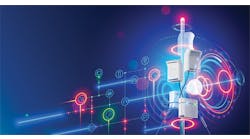The big trend in the European market that many automation suppliers want to be a part of is Industry 4.0—the fourth industrial revolution that is the digitization of the industry. As a German company, Murrelektronik believes this is where it will have the biggest opportunity with its products in the future. It is clear to Murr that production lines are getting more integrated and smarter.
"This is what we are developing, products to be compatible with and to contribute to the fourth industrial revolution," says Rafael Calamari product manager—fieldbus, at Murr. "This is the way everything is going. Machines are becoming part of a unit instead a single part of the system."
To aid the creation of these units in Industry 4.0, Murr recently developed an accessory for its Cube67 line of products. "It's like a monitor device that sends data up to a PLC and at the same time to the office floor," says Calamari. "This brings all monitored sensor and actuator-related signals up to the management level."
Management gets interested in diagnostics if it contributes to higher production and higher efficiency. "We noticed at first that this is important and added as much diagnostics as possible into our products," says Calamari. "What we saw in the past few years is that the machine builders don't care that much about the diagnostics. They don't get any extra money for diagnostics, so they didn't spend the time to implement it. However, the end customers are the ones that need it, and they are interested in it."
Calamari thinks future devices should make the connection at a low price and already have the diagnostics implemented. "This could save days of programming that it would take creating the programming on a PLC," explains Calamari. "We created a device that bypasses the PLC and allows the diagnostics to be displayed on a monitor, HMI, smartphone or tablet."
As a follow-on to this, the device was made more compatible with Industry 4.0. It also integrates with IO-Link and industrial Ethernet allowing all the data, statistics, information and diagnostics from sensors and actuators to be available on the office floor.
"The diagnostic information originally was reactive," says Calamari. "Now, with new devices, we are moving more toward predictive diagnostics. When added to a system, it's not just going to be reactive and report a short circuit or wire break, it will monitor the lifecycle of specific devices and bring this information to the customer who can then plan production stops to maintain the sensor or actuator."
Calamari describes this device as a modular system that is basically a gateway. At a top level, an industrial Ethernet control network and protocol, such as EtherNet/IP or Profinet, is used. In a lower level is internal communication. "The new device designs will bypass the control network," says Calamari. "It communicated from the device to the TCP/IP level, and management level, in an OPC type of way."
An example is in the logistics center in Germany, continues Calamari. "They have devices that are sending data directly to an enterprise-resource-planning (ERP) system, SAP," he says. "In this case, the devices are providing SAP with statistics and information, so the guys in the logistics center can make decisions based on the data that is coming from the floor such as when to stop or when to replace motors, valves or cables."
While the module is just a monitor, once the information is available, a decision can be made to make changes to the field device, using other means because it is connected. "The idea is that all devices in the field can be connected via these devices," says Calamari. "Not only is there feedback from all the devices, but the parameters can be changed, such as sensitivity of a sensor or speed of a motor, depending how production is progressing."
The control network is separate from the diagnostic and information layer, going to the cloud. "Each customer will see Industry 4.0 in a different way and implement it in a different way, so it is important to make the diagnostic gateway available and compatible with a variety of different ERP and cloud platforms," says Calamari.
These gateways will be connecting to industrial Ethernet, fieldbus and IO-Link masters. "The same way devices can push information to the enterprise, ERP and cloud level, the gateway can talk to IO-Link field devices," says Calamari. "This is making the diagnostic information available for things such as power supplies and circuit protectors. The users will be able to set the voltage level, monitor the current consumption for multiple channels and turn the channels on and off. At the same time, the power supply provides feedback to the end user in the form of health monitoring. Data will be available to determine the right time to replace the power supply."
When it comes to smart sensors, IO-Link doesn't have much that is comparable in the market other than using Ethernet all the way to the device. "The idea behind IO-Link was that it was an easy way to add and configure smart sensors in a system," says Calamari. "What we are seeing is that most customers are not prepared to use it. IO-Link is only being used to save installation costs when adding I/O to a system."






